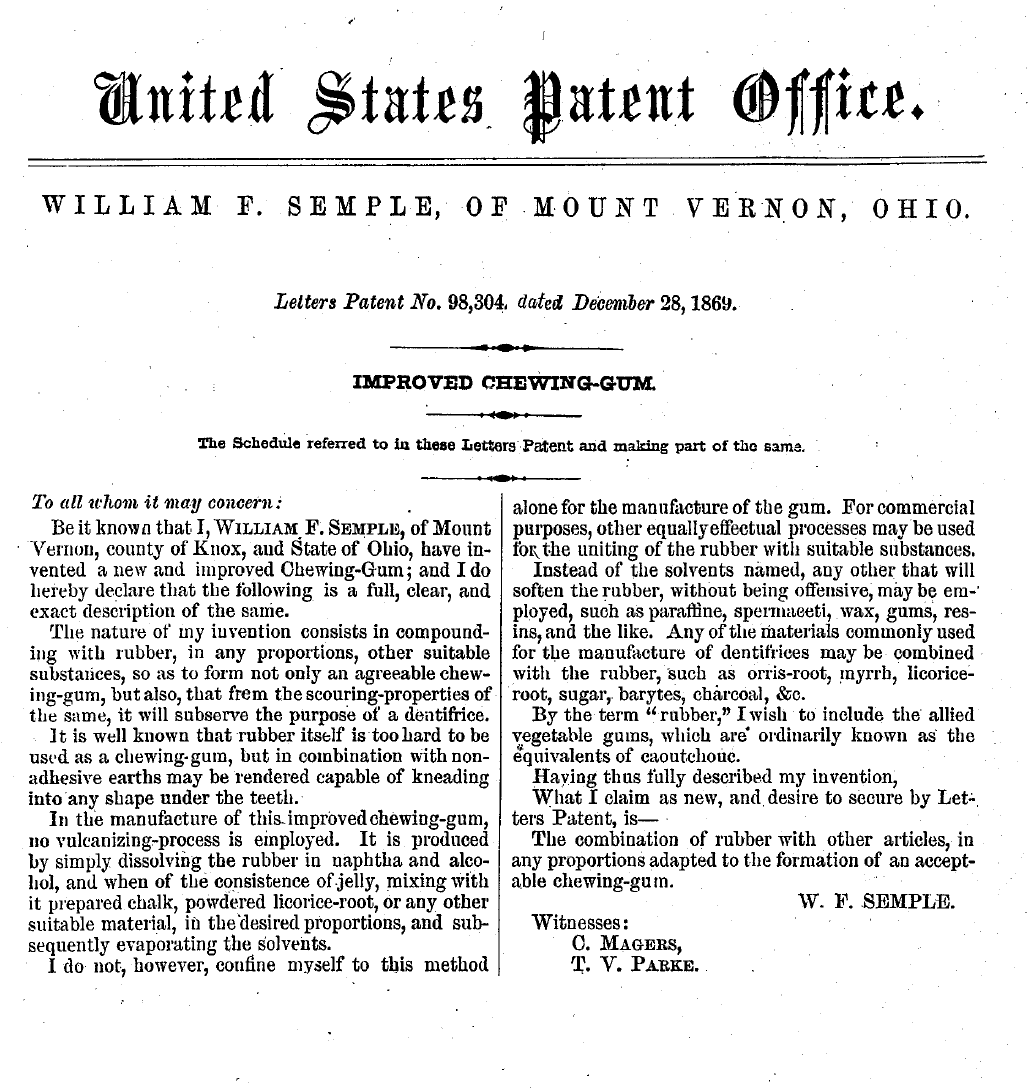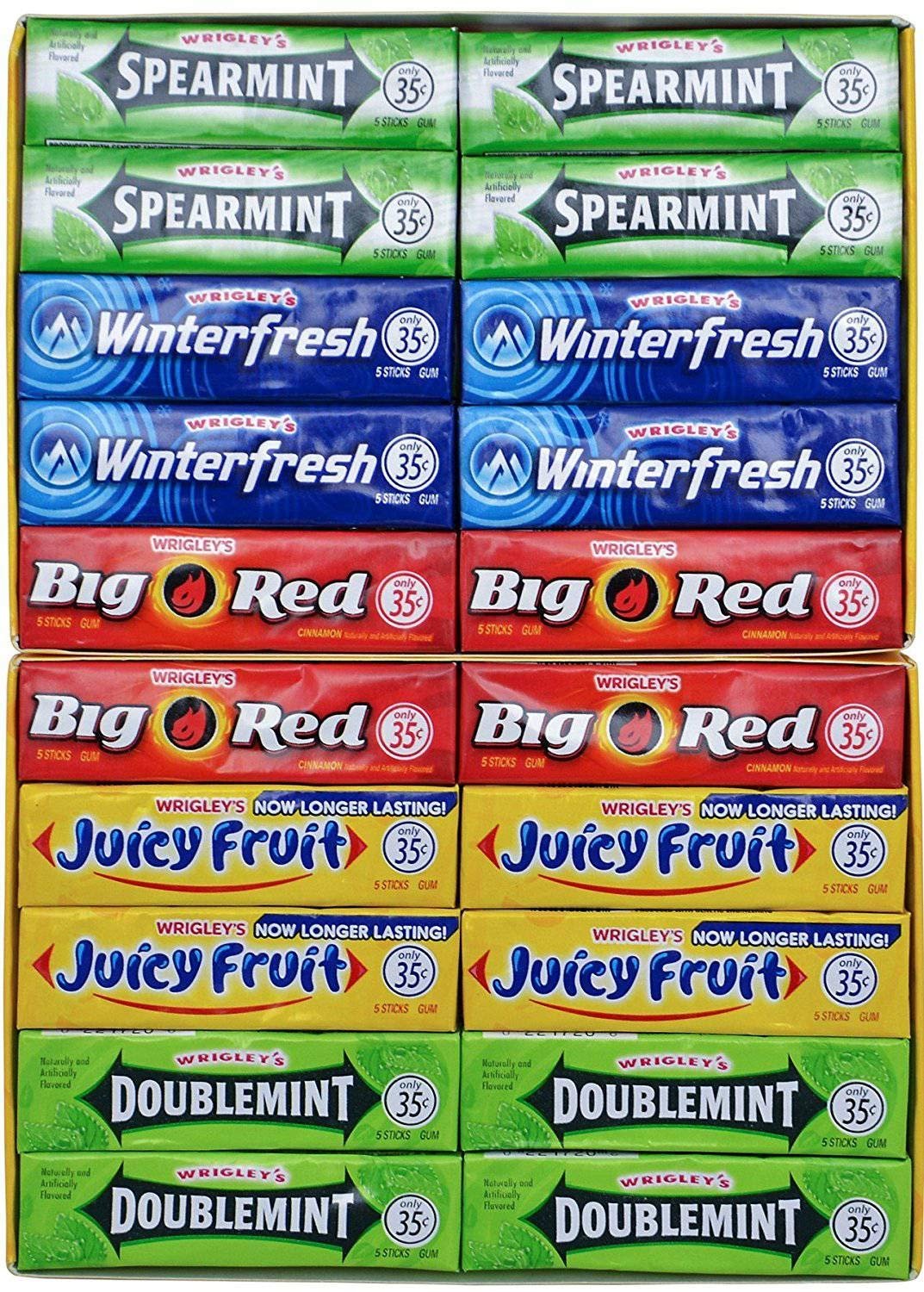I love invention, and the month of December celebrates many unique innovations over time. This blog will focus on one, that teeth-smackin’ and bubble makin’ non-food—chewing gum!
William Finely Semple filed a patent for chewing gum in December 1869.
That doesn’t mean there wasn’t gum chewing prior to 1869. As long as humans have been masticating, we’ve looked for something to gnaw on between meals. Chewing gum in some form or other has existed since the Neolithic period. Scientists found 5,000-year-old chewing gum made from birch bark tar, WITH TOOTH IMPRINTS, in Kierikki, Finland. Think about that fossilization next time you stick gum under a desk or bus stop! (Just say no.)
The Mayans and Aztecs chewed chicle, a natural tree gum, and, adding some practicality, used it to stick objects together. The word chicle comes from the Aztec Nahuatl word "chictli/tzictli," meaning "sticky stuff"
A chiclero bleeding a tree for chicle, Belize 1917 - Wikipedia
When you hear “chicle” you might think of good old Chicklet gum, the candy-coated rounded squares of gum. The brand was introduced in 1900 by the American Chicle Company, a company founded by Thomas Adams. Edward Beeman (Beeman gum) was one of his partners.
By the way, the American Chicle Company was acquired by a pharmaceutical company in 1962, which was acquired by a larger pharmaceutical company in 2000 that you might have heard of lately. Pfizer. But Pfizer didn’t stay in the candy business for long, selling all their candy brands to Cadbury in 2003.
Anyway, back to chicle.
Wrigley used chicle in its gum until land reform law passed in Guatemala in 1952 which ended feudal work relations and expropriated unused lands and sold them to the indigenous and peasants.
By the 1960s, most chewing gum companies had switched from using chicle to butadiene-based synthetic rubber. Sounds yummy, huh? It was definitely cheaper.
Today, Glee Gum, Simply Gum, and Tree Hugger Gum still use chicle.
What else has been the main ingredient of gum over the years?
In ancient Greece, the gum of choice was mastic, also known as Tears of Chios, which sounds like a gum of mythology, a food of the gods, doesn’t it? It is a resin obtained from the mastic tree (Pistacia lentiscus) produced on the island Chios. It’s somewhat hard and bitter at first, but when softened in the mouth releases a refreshing pine and cedar-like flavor. Mmmmm.
Lots of other substances were used to exercise the old jaws around the world:
The Chinese chewed Ginseng plant roots.
Eskimos chewed on blubber.
Native Americans enjoyed sugar pine and spruce sap.
South Americans masticate on the old Coca leaves (which also help with altitude sickness when climbing in the Andes and the highest part of the Inca Trail).
In India, the chewing substance of choice was Betel nuts.
In Tropical West Africa it was Kola nuts.
And early settlers in the US chewed on Tobacco leaves. This of course is still the case for some Americans, only nicotine has been added to tins of chewing Tobacco like Copenhagen to make it highly addictive.
Also found in today’s chewing tobacco are
Polonium 210 (nuclear waste)
Formaldehyde (embalming fluid)
Cadmium (used in car batteries)
Lead (nerve poison)
Nitrosamines (cancer causing substances)
Arsenic
Cyanide
Most brands contain some 3,000 chemicals, including 28 that are known to cause cancer. Much better to stick to gum, if you ask me!
Get it? Stick to…
One of the first commercial gums was developed and sold starting in 1848 by John B. Curtis, a businessman from Maine. He called it The State of Maine Pure Spruce Gum. It used natural products and flavorings. He got the idea when he saw loggers chew spruce resin. When he changed it to flavored paraffin wax gum, it picked up in popularity. Paraffin is a petroleum product. Chewers sometimes dipped it repeatedly in a plate of powdered sugar to maintain its sweetness.
Curtis eventually built a factory in Maine that employed some 200 employees and produced several brands of chewing gum. He became very wealthy.
Dr. William Semple, a dentist, created his 1869 gum (patent # 98,304) by dissolving vegetable gums in naphtha and alcohol until they reached the consistency of jelly. Then he mixed in powdered chalk, powdered licorice root, and other materials to provide texture and flavor. Those included sugar, orris root, and myrrh. Finally, he evaporated the solvents until the material dried and hardened.
Semple thought that people would buy the gum not just to chew for fun, but to help keep their teeth clean and breath fresh. The chalk would have a scouring effect in rubbing away food particles and dental plaque, the sticky film that forms on teeth and causes tooth decay and gum disease. Dentistry wasn’t what it is today in the late 1800s. Folks needed all the help they could get.
Dr. Semple created a selling point for gum that lives on to this day!
Mr. Edward E. Beeman took the health benefits of gum to another level by adding pepsin powder to improve digestion. Pepsin is an enzyme found naturally in the stomach that breaks down proteins. He originally sold the gum in a wrapper that showed the picture of a pig and carried the slogan, "With Pepsin, You Can Eat Like A Pig."
But perhaps the most well known name in the world associated with gum is Wrigley.
William Wrigley Jr., born in 1862 Philadelphia, was the son of a soap manufacturer. A prankster, he was expelled from school. At 13, he began selling Wrigley’s Scouring Soap on the streets. He dreamed of running his own business though. First, he sold soap, offering a free can of baking powder with every sale. Trouble was, baking powder outstripped demand for soap, so Wrigley went into the baking powder business. To spur sales, he again offered an incentive — chewing gum. The chewing gum proved more popular than the product he was selling. Wrigley saw an opportunity. In 1893, he introduced two now-iconic brands — Wrigley’s Spearmint® and Juicy Fruit®.
What set him apart from other gum makers at the time was his use of advertising. He branded his gum before branding was a verb for anything but cattle. He put pictures of his gum everywhere, in newspaper and magazine ads, and on highway billboards. Wrigley became a household name, equivalent with gum.
By 1908, sales of Wrigley’s Spearmint topped $1 million a year and profits just grew from there. In 1921, Wrigley became the majority owner of the Chicago Cubs. When he retired in 1925, Wrigley’s was the top chewing gum manufacturer in the world.
One of Wrigley’s first advertising icons was “Spearman,” introduced in 1915
“Anyone can make gum,” he once said. “The trick is to sell it.”
Wrigley is still the largest manufacturer and marketer of chewing gum in the world today.
This is a trip. In 2006, Wrigley helped establish the Wrigley Science Institute (WSI) to study the oral health benefits of gum chewing. The WSI investigates the effects of gum chewing on weight management, stress relief, concentration, and oral health. That seems pretty self-serving to me.
In 2009, scientists working for WSI found that Chewing gum could have a positive effect on the academic performance of teenagers. They are only the number one consumer group of gum chewers in America. Hmmm…
So, what is your favorite type of gum—if you chew it? Hubba Bubba? Bubblicious? Big League Chew? Mine as a kid was those 1970s footlong sticks of Bub’s Daddy green apple-flavored gum that we’d buy at little league snack shacks. Nowadays, it’s Ice Breakers Arctic Grape Ice Cubes. But I don’t chew it as much as I used to. AND when I do, I don’t want to look too carefully at the list of unpronounceable ingredients, starting with Xylitol—the most common gum ingredient today—a chemical compound sugar substitute. I don’t know, maybe tree resin would be better!
Photo by Piero Regnante on Unsplash










